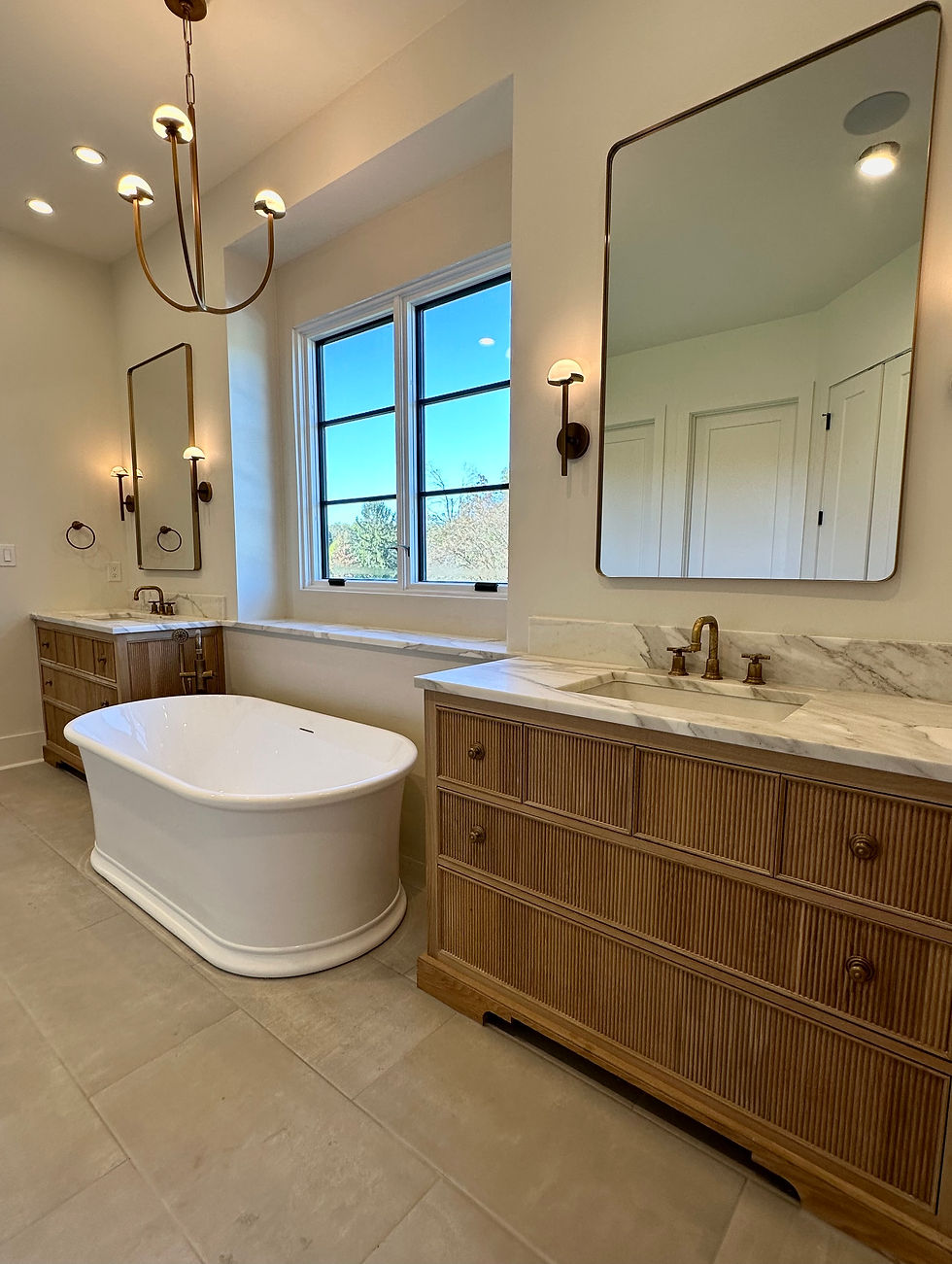Creating Your Ideal Bathroom: A Three Step Guide to Tiles, Colors, and Fixtures
- Christian Tipton

- Nov 18, 2024
- 4 min read
Updated: Nov 19, 2024

Designing a bathroom might seem overwhelming, but breaking it down into simple steps, you can create a space that’s both functional and beautiful. Whether you're doing a full renovation or just refreshing the space, tiles, colors, and fixtures can make a huge difference. Here's a three-step guild though focus areas when designing a bathroom.
Ps. These are just options based off my experience as a bathroom remodeler.
Step 1: Tiles – Choose the Right Tiles for Each Area
Tiles play a big role in the look and feel of your bathroom. They’re also important for practicality, especially in high-moisture areas like showers and floors. Here’s how to pick the right tiles for each area:
1. Shower Floors: Use Small Tiles for Safety and Drainage
Thought: For your shower floor, choose small tiles (like 2x2 inches, 3x3 inches, or small hexagons). The smaller tiles create more grout lines, which improve drainage and provide better slip resistance—important for safety in wet areas. They also allow for a more precise slope toward the drain, helping water flow efficiently. The extra grout lines give the floor more traction, reducing the risk of slipping when wet.
2. Shower Walls: Medium-Sized Tiles for a Clean Look
Thought: Use medium-sized tiles in a shower to create a clean, balanced look with fewer grout lines than smaller tiles. This helps the shower feel more open and less cluttered, making the space appear larger. They also offer flexibility in design, making it easier to create a stylish and functional layout that fits well in any bathroom.
3. Bathroom Floors: Large Tiles for Easy Maintenance
Thought: Use large floor tiles to make the bathroom look modern and spacious by using fewer grout lines, creating a smooth, easy-to-clean surface. The larger tiles help the room feel bigger and more open, especially in smaller spaces. Fewer grout lines also help the bathroom feel more organized and less busy.
Step 2: Colors – Setting the Right Mood for Your Bathroom
Color can completely change the look, and feel, of your bathroom. Here's how I choose the right colors for your tiles, walls, and vanity:
1. Tile Color: Choose a Base Color that Works for Your Style
Thought: Pick your tile color first, as it sets the tone for the entire room. Light shades like white, soft gray, or beige create a clean, airy feel and help the space feel larger. For a more striking look, rich tones like emerald green or deep navy can and depth. The color you choose will shape the overall vibe of the bathroom.
2. Wall Color: Complement Your Tiles
Thought: Choose a wall color that complements your tiles. If your tiles are bold or patterned, opt for neutral walls (such as soft white, light taupe, or pale gray) to keep the look balanced. If you want to make a statement, darker wall colors (like deep teal or charcoal gray) can add drama and create a more striking atmosphere.
Tip for Small Spaces: Lighter walls make a small bathroom feel more open and airy. Darker walls can make a larger bathroom feel more cozy.
3. Vanity Color: Add Personality or Keep It Simple
Thought: Pick a vanity color that matches your vibe. For a classic look, go with soft ivory or light oak. If you want to make a statement, choose a color like navy, charcoal, or dark green.
Step 3: Fixtures – Choosing the Right Metals and Key Elements
When selecting bathroom fixtures, start by choosing a metal finish and use it consistently across all your fixtures for a unified look.
1. Choose a Metal Finish for Your Fixtures
Thought: Choose a single metal finish (like chrome, brushed nickel, matte black, or gold) for all your bathroom fixtures: shower trim, faucets, lighting, mirrors, and accessories.
2. Key Fixtures to Focus On
Shower Trim: Choose showerheads, faucet handles, and controls in your selected metal finish. For a sleek, modern look, brushed nickel or matte black are great options. For a more classic or luxurious feel, consider using brass or gold.
Vanity Faucets: Match the sink faucet to the shower trim for a cohesive look. Choose a single-handle faucet for a modern, minimalist style, or go for a vintage-style faucet with separate hot and cold handles for a more traditional feel.
Lighting: Choose vanity lighting in the same finish as your faucets and shower trim. Wall-mounted sconces or a lighted mirror can elevate the space. The style and brightness of your lighting can also change the room’s mood—brighter lights create a more energetic feel, while softer lighting creates a calm, inviting space.
Mirrors: Consider the size of your mirror and the style of other hardware accessories, like towel bars, soap dishes, and hooks. A larger mirror can make the space feel bigger, while smaller mirrors work well in more compact bathrooms.
Choosing a metal finish for your key fixtures will give your bathroom a cohesive, intentional look. From faucets to lighting, selecting the right metal finish helps unify the space and create a seamless design throughout the room.
Final Thoughts: Design Your Bathroom with Confidence
Designing a bathroom doesn’t have to be overwhelming. By focusing on the essentials—tiles, colors, and fixtures—you can create a space that’s both practical and beautiful. Start by selecting the right tiles for each area, choose colors that match your style, and pick fixtures that align with both your aesthetic and functional needs. Take it one step at a time, and soon you’ll have a bathroom you’ll love—ready for us to bring it to life.


Comments